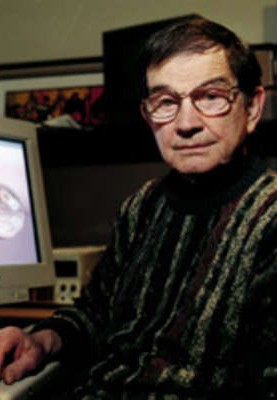-
(b.) - ?1922 July 04
Bio/Description
Labeled as an 'Old Master' in a new medium, he is best known for pioneering the field of computer graphics, computer animation and digital fine art, creating his first computer art in 1964. He has been recognized as the father of digital art and computer animation by Smithsonian. In 1964, when he decided to turn the computer into an artist's tool, the computer confronting him was a huge mainframe that required the entry of its data through punched cards. He had to become a programmer to talk to it. Until recent years, he wasn't making any art, except in his mind; he was developing the programs he needed to make the art he imagined. Although there are now some powerful paint programs that allow artists to draw on a touch-sensitive tablet, and watch their work appear on the screen while the computer provides a choice of brushstrokes and colors, he largely forgoes this more direct interaction with the computer. Instead, he continues to type away in the arcane jargons of computer languages, scripts, codes and menu selections, using a sophisticated computer that lets him sculpt images in three dimensions, set them in motion, and alter them in ways that often blur the distinctions between special effects and art. Yet, as he points out, "even though we have all this marvelous technology, you still need to have an esthetic sensibility; you need a sense of culture and history (for the image to work as art). That has not changed." Born in Grant Town, West Virginia, he is a World War II veteran, having served his country from 1943-1946. In 1945 he received the Bronze Star for heroism in the Battle of the Bulge. After WWII, he returned to Ohio State to complete his M.A. degree in Art in 1948. In 1949 he joined the faculty of the Department of Art The Ohio State University. In 1978 he became a Professor of Art Education and in 1986 a Professor of Computer Information Science. He is still a Professor Emeritus at The Advanced Computing Center for Art and Design The Ohio State University. Between 1971 and 1987, while a senior Professor at the Ohio State University, he founded the Computer Graphics Research Group, the Ohio Super Computer Graphics Project, and the Advanced Computing Center for Art and Design, dedicated to the development of digital art and computer animation. He was also co-founder of Cranston/Csuri Productions (CCP), one of the world's first computer animation production companies. In 2000 he received both the 2000 Governor's Award for the Arts for the best individual artist, and The Ohio State University Sullivant Award, that institution's highest honor, in acknowledgment of his lifetime achievements in the fields of digital art and computer animation. His current exhibition "Beyond Boundaries" is a retrospective of seventy of his most groundbreaking works of computer art. The exhibition is scheduled to travel to museums in Europe and Asia. He is the founder of Ohio State's celebrated research center, The Advanced Computing Center for the Arts and Design (ACCAD). He is acknowledged as a leading pioneer of computer animation by the Museum of Modern Art (MoMA) and The Association for Computing Machinery Special Interest Group Graphics (ACM SIGGRAPH). He is in the Football Hall of Fame as M.V.P. in the Big Ten Conference and captain of the Ohio State University's first national championship football team in 1942. He was a 16th round selection (154th overall pick) in the 1944 NFL Draft by the Chicago Cardinals.
-
Date of Birth:
1922 July 04 -
Noted For:
Pioneer in digital fine art and computer animation -
Category of Achievement:
-
More Info:


